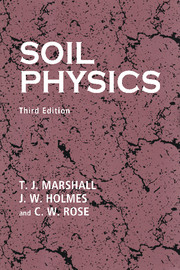Book contents
- Frontmatter
- Contents
- Preface
- Preface to the second edition
- Preface to the first edition
- 1 Composition of soil
- 2 Interaction of soil and water
- 3 Measurement of water content and potential
- 4 Principles of water movement in soil
- 5 Distribution of water in soil
- 6 Ground water in soils and aquifers
- 7 The use of isotopes and other tracers in soil water and groundwater studies
- 8 Soil structure
- 9 Deformation of soil
- 10 Management of soil water
- 11 Soil erosion and conservation
- 12 Chemical transport in soil
- 13 The physical environment of roots
- 14 Plants and soil water
- Appendixes
- References
- Index
5 - Distribution of water in soil
Published online by Cambridge University Press: 05 June 2012
- Frontmatter
- Contents
- Preface
- Preface to the second edition
- Preface to the first edition
- 1 Composition of soil
- 2 Interaction of soil and water
- 3 Measurement of water content and potential
- 4 Principles of water movement in soil
- 5 Distribution of water in soil
- 6 Ground water in soils and aquifers
- 7 The use of isotopes and other tracers in soil water and groundwater studies
- 8 Soil structure
- 9 Deformation of soil
- 10 Management of soil water
- 11 Soil erosion and conservation
- 12 Chemical transport in soil
- 13 The physical environment of roots
- 14 Plants and soil water
- Appendixes
- References
- Index
Summary
The movement of water through the soil, as discussed in Chapter 4, can sometimes be regarded as being in the steady state. There can then be no time-dependent change in the water content of the soil and a study of any particular zone of the soil presupposes that the fluxes of water across the boundaries of that zone can be specified, and that inflow and outflow just balance. This approach has been particularly useful in developing drainage theory, as will be shown subsequently in Chapter 6. The accurate satisfaction of the steady-state criteria may not be necessary if the time scale of interest is so long that short-term variations in water content of the soil, and lack of balance between inflow and outflow at the boundaries, can be smoothed over and eliminated on a longer scale of time. Rapid movements of water into and through the soil, however, cannot be described satisfactorily by the steady-state approach. Infiltration of rainwater or irrigation water through the soil surface and the descent of a wetting front into relatively dry soil is one of the basic natural processes. The life-environment of terrestrial plants includes this zone of intermittent or cyclical wetting of the soil. In this chapter the theory of infiltration of water will be described, together with the subsequent redistribution of water from wet to dry soil.
- Type
- Chapter
- Information
- Soil Physics , pp. 107 - 139Publisher: Cambridge University PressPrint publication year: 1996



